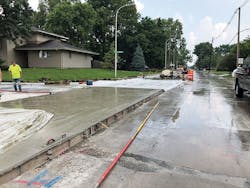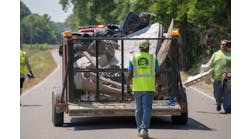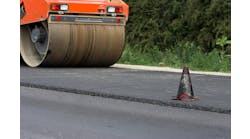Alkali-silica reaction, commonly referred to simply as ASR, is considered to be, by those in the know, concrete cancer.
According to the Portland Cement Association, ASR occurs when aggregates containing certain forms of silica react with alkali hydroxide in concrete to form a gel that swells as it adsorbs water from the surrounding cement paste or the environment, resulting in the accelerated and pervasive degradation of the pavement. Such were the conditions faced by engineers from the city of Urbana, Illinois in the summer of 2020, as they looked at reconstructing the intersection of Vine and Washington streets, an area couched in a densely residential area.
“This road was last reconstructed about 10-15 years ago,” Shannon Beranek, project manager and engineer for the city of Urbana, told Roads & Bridges. “In order to get in there when the middle school was out, because it is right next to Urbana Middle School, the speculation is that, at that time, they used a fast-setting concrete. Whether this is true or not, the result was that all of the concrete that was put down back then developed ASR, and it severely deteriorated the road.”
The intersection of Vine and Washington is a skewed intersection skirting a couple of neighborhoods and a multiuse athletic field that feeds directly into the Urbana Middle School property. Consequently, designers Fehr-Graham faced some interesting challenges in order to get the joints and reinforcement to lay out correctly.
Beranek, as project manager, spearheaded the effort to assess precisely what would be called for to rescue the road.
“We hired a consultant, and they advised a series of full- and partial-depth patching,” she said. “But when I went out to inspect the site, it was much worse than expected. The joints were much further gone. The ASR had really progressed. Cracking everywhere. Our operations department had put down cold-patch to hold things together as much as they could over the years, but to have gone with that initial assessment would have meant 35% patching. After 30% you’re really just throwing money down a hole, basically. And it would just lead to more and more problems that would accelerate through Illinois’ weather—very hot summers, very cold winters, all sorts of precipitation conditions. So I and my tech proposed a full rebuild and, luckily, the city was on board.”
A few surprises early on
Due to the relative unknown factor of exactly what lay beneath the degraded surface course, an initial challenge for Beranek and contractor Feutz Contractors Inc. was determining what was salvageable and what would require a more invasive method of restoration and stabilization. The existing roadway had been constructed with concrete that had extensive material failures and did not nearly come close to meeting its design life. Moreover, during that pavement’s construction, many in-field changes were made that were not recorded, leaving the new planners much in the way of guesswork.
“In theory, it should have been a 9-in. pavement,” Beranek said. “That’s what the plan from the last rebuild had said. But in reality, it was anywhere from 9 in. to over 1 ft thick. Part of the unknown was that we didn’t know what was under it. We knew there was a base course and some stabilizing fabric. In some places, in fact, the pavement was right on top of that fabric, no intermediate course. In some places the base was 6 in. thick; in others it was less than 2 in. thick. It actually became a bit of a running joke as we demoed—you know, ‘What are we going to dig up today, Jimmy Hoffa? Because that’s how far we have to go down.’”
As demo work got underway, planners, erring on the side of caution, simply assumed that all the base and fabric would need replacing.
“Since we didn’t know what was under there, I built that into the contract,” Beranek confirmed.
After demolition was completed, followed by a brief run of compaction to try to save the base, the city brought in a consulting company to perform density tests on the subgrade. Unfortunately, some of Beranek’s early suspicions were confirmed: “The results were just all over the place. I watched the tester and he could not drive his pin to hold the gauge in place at all. The tests failed because it wasn’t dense enough. So I decided to try a proof roll test.”
In a proof roll test, a dump truck fully loaded with the aggregate intended for use as the base is driven over the existing base. By doing so, it becomes fairly easy to see where stabilization is required.
“Initially, we had a driver that tore up some fabric, but past that we learned there wasn’t much to fix,” Beranek said. “We had to fix some patch spots, but overall we got a good 4-6 in. base course over the top of the fabric.”
This was a welcome relief, because more challenges were ahead, not least of which were the combined factors of a tight summer timeline and the reality of COVID-19.
Time crunches and downpours
The timeline for the project was determined pre-COVID, and it was based on Urbana Middle School’s class schedule.
“The contract required the contractor to not start until after school let out and to finish before school went back into session for fall 2020,” Beranek said. “Being as this was a summer project on a tight schedule, the days where we had to stop pouring concrete before noon because the concrete would get beyond acceptable temperatures added a further time crunch. There was also a hailstorm that caused extensive damage through the city, though fortunately we didn’t have fresh concrete at the time. There were other severe storms—sudden downpours that came out of nowhere—where we did have to repair concrete even after covering it proactively with plastic—that’s how bad the storm was. There was also an instance where we were waiting for plastic to protect what we had paved, when the rain just pummeled the road, but after that we always had plastic ready to go.”
A grace note to the environmental challenges was a relative dearth of utility concerns. A few manholes needed to be raised, some curblines were shifted, but it was nothing crews could not handle in the field—in other words, nothing that required a sizable design change. “We contacted the water company to offer to let them in there when the road was torn up,” Beranek said, “but this area was not on their slate, so it wasn’t a concern.
“We did have to redo every single ramp, though. IDOT requires that when you do a resurface that’s more than just, say, a chip seal, you also have to reconstruct the ramps. Even though the design plans were solid, we still had to address most of the ramps in the field, due to so many constrictions in the environment that made ADA compliance a challenge. It was myself and the concrete contractor standing there sometimes with calculators and string.”
Paving operations took place with few hiccups. The subbase in this area was largely clay, upon which the stabilizing fabric settled nicely. Atop that, crews placed (or restored in-place) 4-6 in. of aggregate base, which made the surface course a uniform 9.5 in. of standard Illinois DOT mix and a quicker-setting rich mix that was approved by IDOT as the project due date approached and cure time needed to be reduced.
“It was written into the contract nothing fast-setting, to avoid the same problem we faced happening again in the future,” Beranek conceded. “But we ran into time constraints, so IDOT approved the rich mix.” Doing so cut cure time from seven to 3-4 days.
Such a decision, however, might not have been necessary had two random, unfortunate events not occurred.
One drunkie and an impatient garbageman
During construction, a drunk driver plowed his way across a stretch of freshly laid aggregate base, running over several barricades in the process. “Thankfully, that caused minimal damage,” Beranek said, “though we did lose a day fixing up the spot he drove over. Actually, it did more damage to his vehicle than to our site. He popped all four tires and ripped off a mirror!”
A more serious incident happened right at the tail end of construction, when a garbage truck driver decided that a closed road should be no impediment to him going the way he wanted to go.
“You wouldn’t believe it,” Beranek said. “He got out of the truck, moved the barricades, and drove over concrete that was less than 22 hours old. We got him on camera from the bank and the gas station across the street. We lost about a day dealing with police and attorneys and so forth. The trucking company is now on the hook for any cracking or failures on the concrete for the next year or so.”
Community relief
Though the school was on board with the work, and the contractor was amenable to keeping the set schedule despite COVID, the neighborhood proved to be more of a challenge.
“The alderman at the time was NIMBY on the whole thing,” Beranek recalled. “He wanted it fixed but not so as to disrupt his way of life. He’d come down and stare at the crew while they worked. And some of the local residents did not want this happening in front of their houses, though there were others who were quite supportive. Of course, the supportive brought donuts and coffee, and the other once tried to run me over with his car! This was also adjacent to a historic area of town, which we had to detour through, and we had several complaints about that. The difficulty, I think, was not being able to have a full open house with the community because of COVID.”
Yet when the work was done, one contracted element added by Beranek proved to be precisely the olive branch the community needed to come in on the side of progress: “Included in the design at my request was enhanced stop signage on the north- and southbound approaches. Due to this being right in the middle of a neighborhood, it was decided not to go with a full signal, but rather solar-powered flashing stop signs that run from 7 a.m. to 7 p.m. That has gone over very well. The neighborhood is very pleased with those signs. We get lots of compliments, and even our operations guys are wild about them.”



